Novel Sustainable Masonry from Ancient Construction Techniques by Reusing Waste Modern Tiles
Abstract
:1. Introduction
2. Materials and Methods
2.1. Technological-Constructive Systems of Tiles Masonries
- FMT (Fragmented Modern Tiles): in which the first layer is made by tile fragments placed with their raised edge towards the outside, and the second one fills the internal U-gap and is always made by tile fragments (Figure 2). This type is inspired by the previous Romanesque walls Three walls of the nominal size 1.00 × 0.39 × 0.78 m3 (Figure 2b,c) were made by this construction technique. This type of masonry requires additional skills, and it is a little bit more time-consuming than the first one.
- WMT (Whole Modern Tiles): in which the first layer is made by unbroken tiles placed with their raised edges towards the outside, and the second one fills the internal U-gap and is made by tile fragments (Figure 3). This type is inspired by the previous Roman walls. Three walls of the nominal size 0.95 × 0.35 × 0.80 m3 were made by this construction technique (Figure 3b,c).
2.2. The Mortar
2.3. The Tiles
2.4. Compression Tests on Wall Specimens
3. Results
3.1. Monotonic and Cyclic Tests
- is the total vertical load at the base of each level of the building, corresponding to the sum of the permanent and variable loads (combination coefficients are equal to 1);
- is the total area of load-bearing walls of the same floor;
- is the characteristic compressive strength of the masonry;
- is the partial safety factor of the compressive strength of the masonry, equal to 4.2.
- That all the limitations about the openings of the masonry and the dimensions of seismic-resistant walls are respected;
- The lowest compressive strength (1.28 MPa = 1280 kN/m2) among all the tested specimens, obtained for WMT_3, even if this sample manifested clear problems, we considered the worst condition.
- The maximum admissible floor height (3.5 m) and an appropriate overload for wooden roof slab and wooden inter-floor slab (2.0 kN/m2) for such simple buildings.
3.2. Failure Mode
- the Poisson’s effect, when the raised edges are still intact, as represented in Figure 8c,d). This type of breaking appeared only in WMT_1 and WMT_2;
- the irregularities of the tile fragments as well as the presence of gravel in the mortar, which can cause local stress concentrations on the unbroken tile below, bringing to the V-inside out shaped cracks shown in Figure 8e,f. Even this type of crack is limited to WMT_1 and WMT_3.
4. Discussion
5. Conclusions
Author Contributions
Funding
Institutional Review Board Statement
Informed Consent Statement
Data Availability Statement
Acknowledgments
Conflicts of Interest
References
- Vieira, C.S.; Pereira, P.M. Use of Recycled Construction and Demolition Materials in Geotechnical Applications: A Review. Resour. Conserv. Recycl. 2015, 103, 192–204. [Google Scholar] [CrossRef]
- European Parliament. European Union Directive 2008/98/EC of the European Parliament and of the Council of 19 November 2008 on Waste and Repealing Certain Directives. Off. J. Eur. Union 2008, 51, 3–30. [Google Scholar]
- European Commission (DG ENV) Service Contract on Management of Construction and Demolition Waste—SR1, Final Report Task 2, Bio Intell Serv. 33; Bio Intelligence Service: Paris, France, 2011.
- Robayo-Salazar, R.; Valencia-Saavedra, W.; Mejía de Gutiérrez, R. Reuse of Powders and Recycled Aggregates from Mixed Construction and Demolition Waste in Alkali-Activated Materials and Precast Concrete Units. Sustainability 2022, 14, 9685. [Google Scholar] [CrossRef]
- Mariaková, D.; Mocová, K.A.; Pešta, J.; Fořtová, K.; Tripathi, B.; Pavlů, T.; Hájek, P. Ecotoxicity of Concrete Containing Fine-Recycled Aggregate: Effect on Photosynthetic Pigments, Soil Enzymatic Activity and Carbonation Process. Sustainability 2022, 14, 1732. [Google Scholar] [CrossRef]
- Robayo-Salazar, R.A.; Valencia-Saavedra, W.; de Gutiérrez, R.M. Construction and Demolition Waste (Cdw) Recycling—As Both Binder and Aggregates—In Alkali-Activated Materials: A Novel Re-Use Concept. Sustainability 2020, 12, 5775. [Google Scholar] [CrossRef]
- Robalo, K.; Costa, H.; do Carmo, R.; Júlio, E. Experimental Development of Low Cement Content and Recycled Construction and Demolition Waste Aggregates Concrete. Constr. Build. Mater. 2021, 273, 121680. [Google Scholar] [CrossRef]
- Tošić, N.; de la Fuente, A.; Marinković, S. Shrinkage of Recycled Aggregate Concrete: Experimental Database and Application of Fib Model Code 2010. Mater. Struct. Mater. Et Constr. 2018, 51, 126. [Google Scholar] [CrossRef] [Green Version]
- Gomes, M.; de Brito, J. Structural Concrete with Incorporation of Coarse Recycled Concrete and Ceramic Aggregates: Durability Performance. Mater. Struct. Mater. Et Constr. 2009, 42, 663–675. [Google Scholar] [CrossRef]
- Ferreira, R.L.S.; Anjos, M.A.S.; Nóbrega, A.K.C.; Pereira, J.E.S.; Ledesma, E.F. The Role of Powder Content of the Recycled Aggregates of CDW in the Behaviour of Rendering Mortars. Constr. Build. Mater. 2019, 208, 601–612. [Google Scholar] [CrossRef]
- Durgun, M.Y. Experimental Research on Gypsum-Based Mixtures Containing Recycled Roofing Tile Powder at Ambient and High Temperatures. Constr. Build. Mater. 2021, 285, 122956. [Google Scholar] [CrossRef]
- Varun Raj, P.; Surya Teja, P.; Sai Siddhartha, K.; Kalyana Rama, J.S. Housing with Low-Cost Materials and Techniques for a Sustainable Construction in India-A Review. Mater. Today Proc. 2020, 43, 1850–1855. [Google Scholar] [CrossRef]
- Ohama, Y. International Workshop on Disposal and Recycling of Organic (Polymeric) Construction Materials. Mater. Struct. 1995, 28, 615–616. [Google Scholar] [CrossRef]
- Raut, A.N.; Gomez, C.P. Development of Thermally Efficient Fibre-Based Eco-Friendly Brick Reusing Locally Available Waste Materials. Constr. Build. Mater. 2017, 133, 275–284. [Google Scholar] [CrossRef] [Green Version]
- Rosca, B. Comparative Aspects Regarding Concrete of Structural Grade Made with Recycled Brick Aggregate with/without Fine Particles from Crushing. Mater. Today Proc. 2022, 60, 982–987. [Google Scholar] [CrossRef]
- Cobîrzan, N.; Balog, A.-A.; Thalmaier, G.; Nasui, M.; Munteanu, C.; Babota, F. Microscopical and Macroscopical Analysis of Recovered Bricks for Assessing Their Reusability in Masonry Buildings. Procedia Manuf. 2020, 46, 144–149. [Google Scholar] [CrossRef]
- Giuliani, C.F. L’edilizia Nell’antichità. Nuova Ediz.; Manuali Universitari: Carocci, Ireland, 2018; ISBN 9788843092307. [Google Scholar]
- Mannoni, T.I. Problemi Dei Laterizi Altomedievali. Ravenna Studi. E Ric. 2000, 7, 213–221. [Google Scholar]
- Giorgi, E.L.G. Archeologia Nella Valle Del Cesano Tra Suasa e Santa Maria in Portuno. 2010. Available online: https://www.antequem.it/it/Studi-e-scavi/Archeologia-nella-valle-del-Cesano-da-Suasa-a-Santa-Maria-in-Portuno-c137 (accessed on 8 February 2023).
- Esposito, D. Tecniche Costruttive Murarie Medievali: Murature “a Tufelli” in Area Romana; “L’Erma” di Bretschneider: Rome, Italy, 1998. [Google Scholar]
- Frugoni, C. L’antichità: Dai Mirabilia Alla Propaganda Politica. In Memoria Dell’antico Nell’arte Italiana, Vol. I: L’uso Dei Classici; Einaudi: Torino, Italy, 1984. [Google Scholar]
- Quagliarini, E.; Lenci, S.; Piattoni, Q.; Bondioli, F.; Bernabei, I.; Lepore, G.; Zaccaria, M. Experimental Analysis of Romanesque Masonries Made by Tile and Brick Fragments Found at the Archaeological Site of S. Maria in Portuno. Int. J. Archit. Herit. 2014, 8, 161–184. [Google Scholar] [CrossRef]
- Graziani, L.; Quagliarini, E.; D’Orazio, M.; Lenci, S.; Scalbi, A. A More Sustainableway for Producing RC Sandwich Panels On-Site and in Developing Countries. Sustainability 2017, 9, 472. [Google Scholar] [CrossRef] [Green Version]
- Segura, J.; Pelà, L.; Roca, P. Monotonic and Cyclic Testing of Clay Brick and Lime Mortar Masonry in Compression. Constr. Build. Mater. 2018, 193, 453–466. [Google Scholar] [CrossRef]
- Andreev, K.; Yin, Y.; Luchini, B.; Sabirov, I. Failure of Refractory Masonry Material under Monotonic and Cyclic Loading—Crack Propagation Analysis. Constr. Build. Mater. 2021, 299, 124203. [Google Scholar] [CrossRef]
- Oliveira, D.v.; Lourenço, P.B.; Roca, P. Cyclic Behaviour of Stone and Brick Masonry under Uniaxial Compressive Loading. Mater. Struct. Mater. Et Constr. 2006, 39, 247–257. [Google Scholar] [CrossRef] [Green Version]
- Ispir, M.; Ilki, A. Behavior of Historical Unreinforced Brick Masonry Walls under Monotonic and Cyclic Compression. Arab. J. Sci. Eng. 2013, 38, 1993–2007. [Google Scholar] [CrossRef]
- UNI EN 1052-1; 2001—Methods of Test for Masonry Determination of Compressive Strengt. UNI Technical Commisson: Milan, Italy, 2001.
- UNI EN 12390-3; Testing Hardened Concrete. Part 3: Compressive Strength of Tes Specimens. UNI Technical Commisson: Milan, Italy, 2003.
- UNI EN 772-1; Methods of Test for Masonry Units. Determination of Compressive Strength. UNI Technical Commission: Milan, Italy, 2015.
- Ministero delle Infrastrutture e dei Trasporti Norme Tecniche per Le Costruzioni. DM 17/1/2018; Gazzetta Ufficiale della Repubblica Italiana: Rome, Italy, 2018; pp. 1–198.
- Ministero delle Infrastrutture e dei Trasporti CIRCOLARE 21 Gennaio 2019, n. 7 C.S.LL.PP. Istruzioni per l’applicazione Dell’«Aggiornamento Delle “Norme Tecniche per Le Costruzioni”» Di Cui al Decreto Ministeriale 17 Gennaio 2018; Gazzetta Ufficiale della Repubblica Italiana: Rome, Italy, 2019; Volume 35, pp. 1–337.
- Quagliarini, E.; Stazi, A.; Pasqualini, E.; Fratalocchi, E. Cob Construction in Italy: Some Lessons from the Past. Sustainability 2010, 2, 3291–3308. [Google Scholar] [CrossRef] [Green Version]
- Quagliarini, E.; Maracchini, G. Experimental and FEM Investigation of Cob Walls under Compression. Adv. Civ. Eng. 2018, 2018, 21–29. [Google Scholar] [CrossRef]
- Jayasinghe, C.; Kamaladasa, N. Compressive Strength Characteristics of Cement Stabilized Rammed Earth Walls. Constr. Build. Mater. 2007, 21, 1971–1976. [Google Scholar] [CrossRef]
- Quagliarini, E.; Lenci, S.; Iorio, M. Mechanical Properties of Adobe Walls in a Roman Republican Domus at Suasa. J. Cult. Herit. 2010, 11, 130–137. [Google Scholar] [CrossRef]
- Turk, J.; Cotič, Z.; Mladenovič, A.; Šajna, A. Environmental Evaluation of Green Concretes versus Conventional Concrete by Means of LCA. Waste Manag. 2015, 45, 194–205. [Google Scholar] [CrossRef]

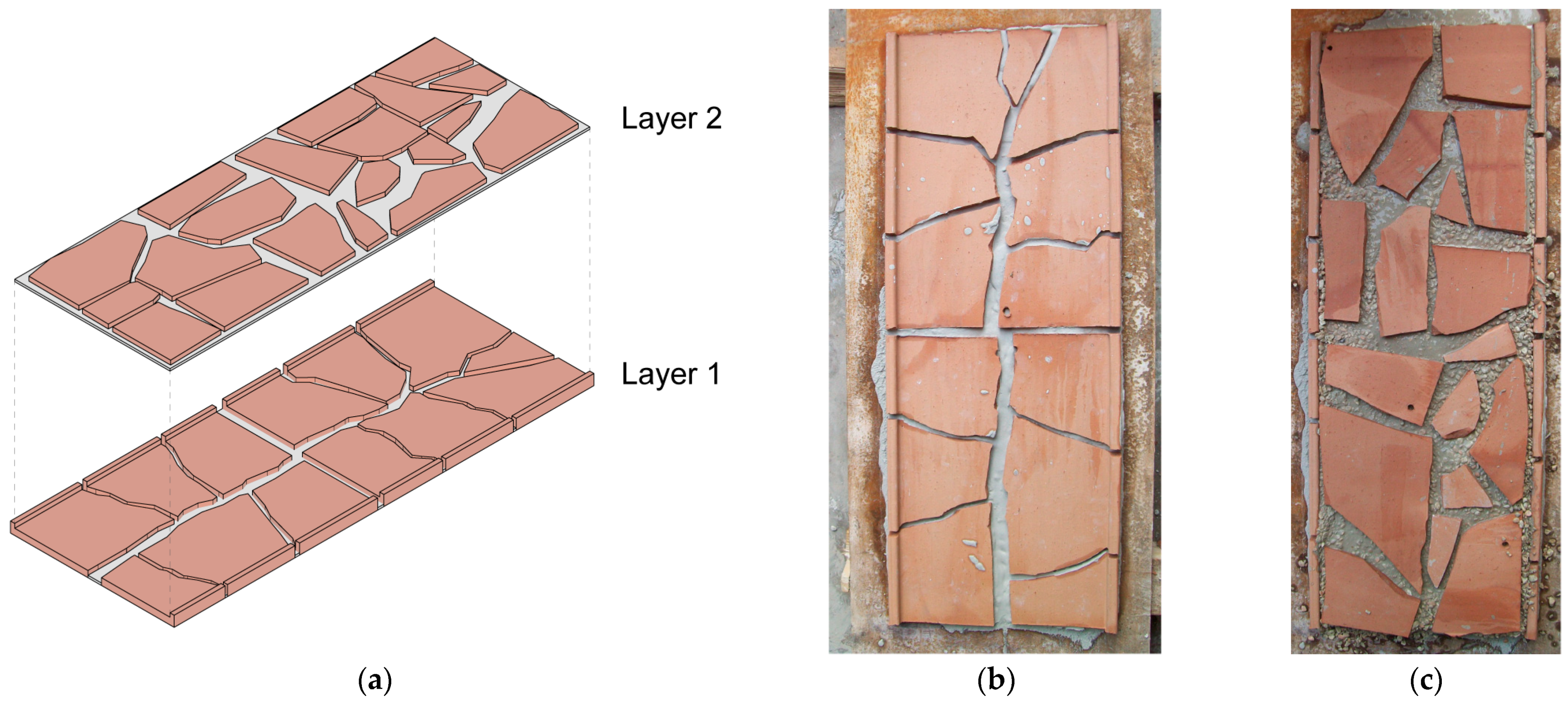

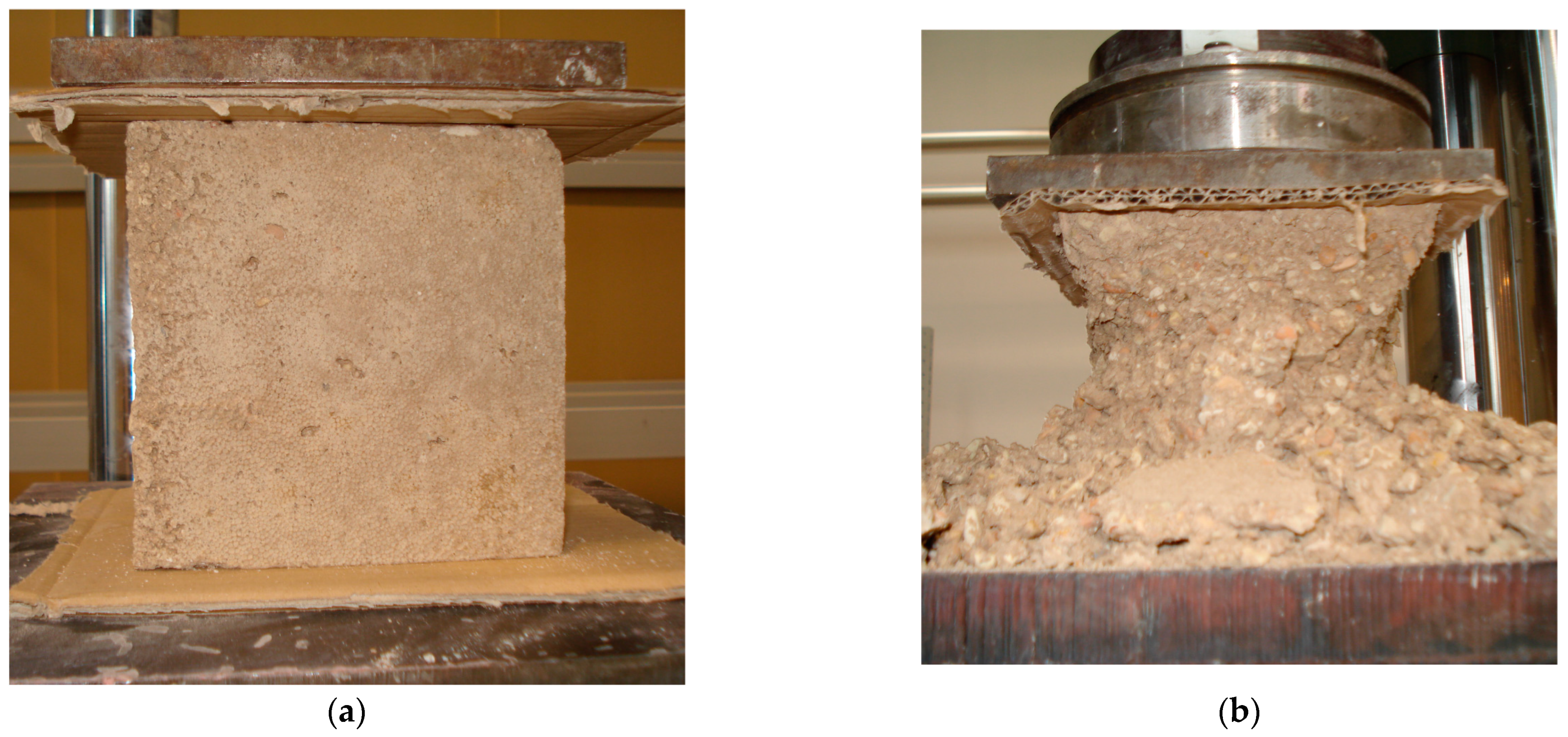

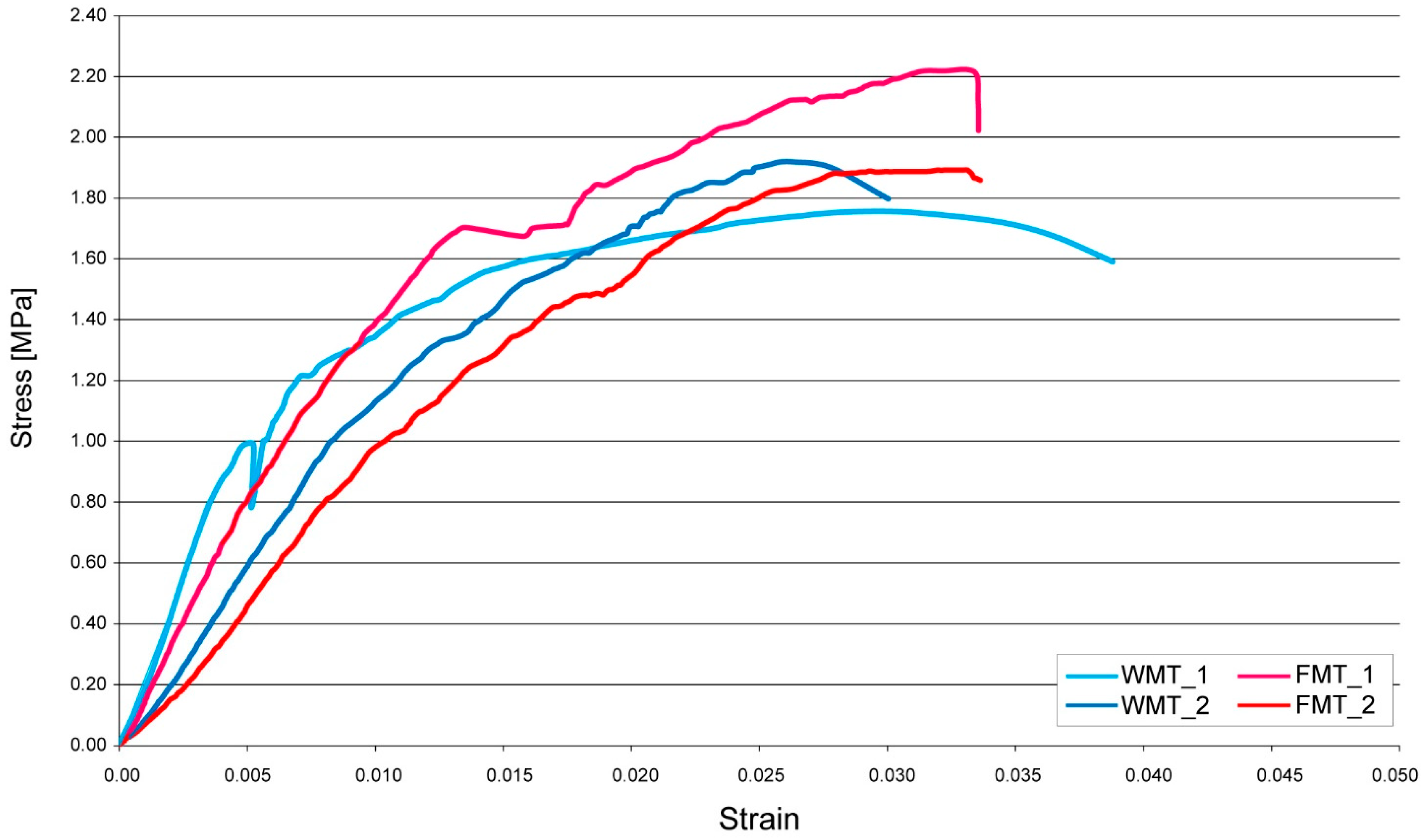
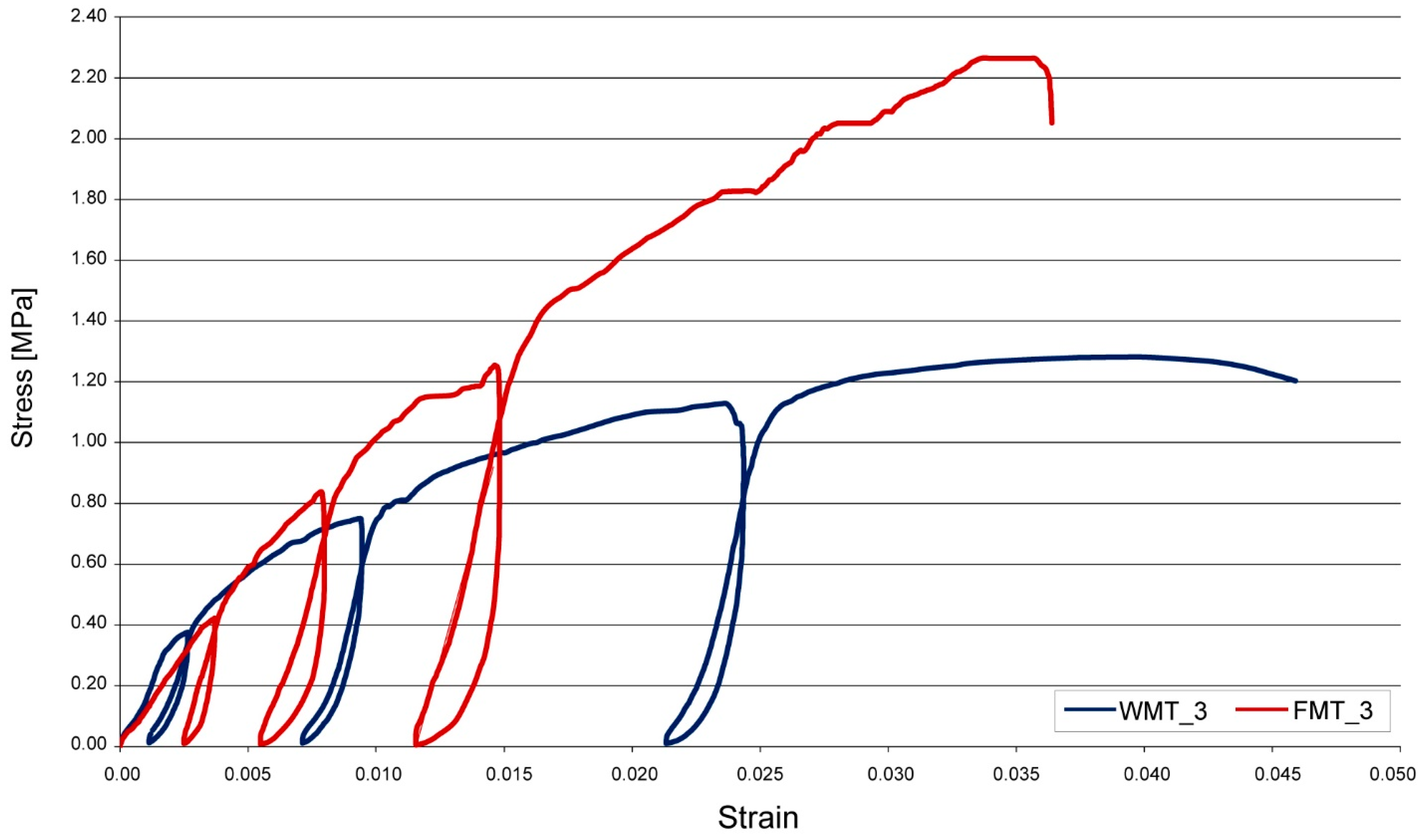

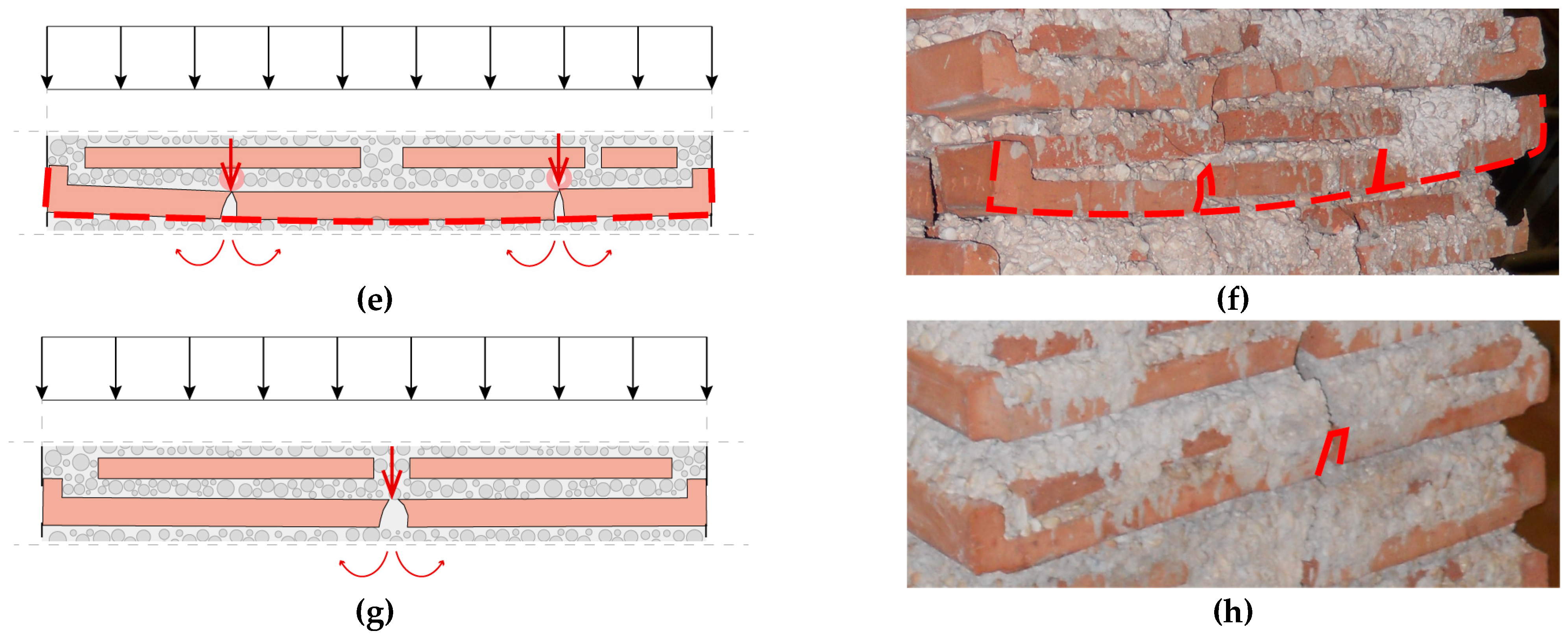
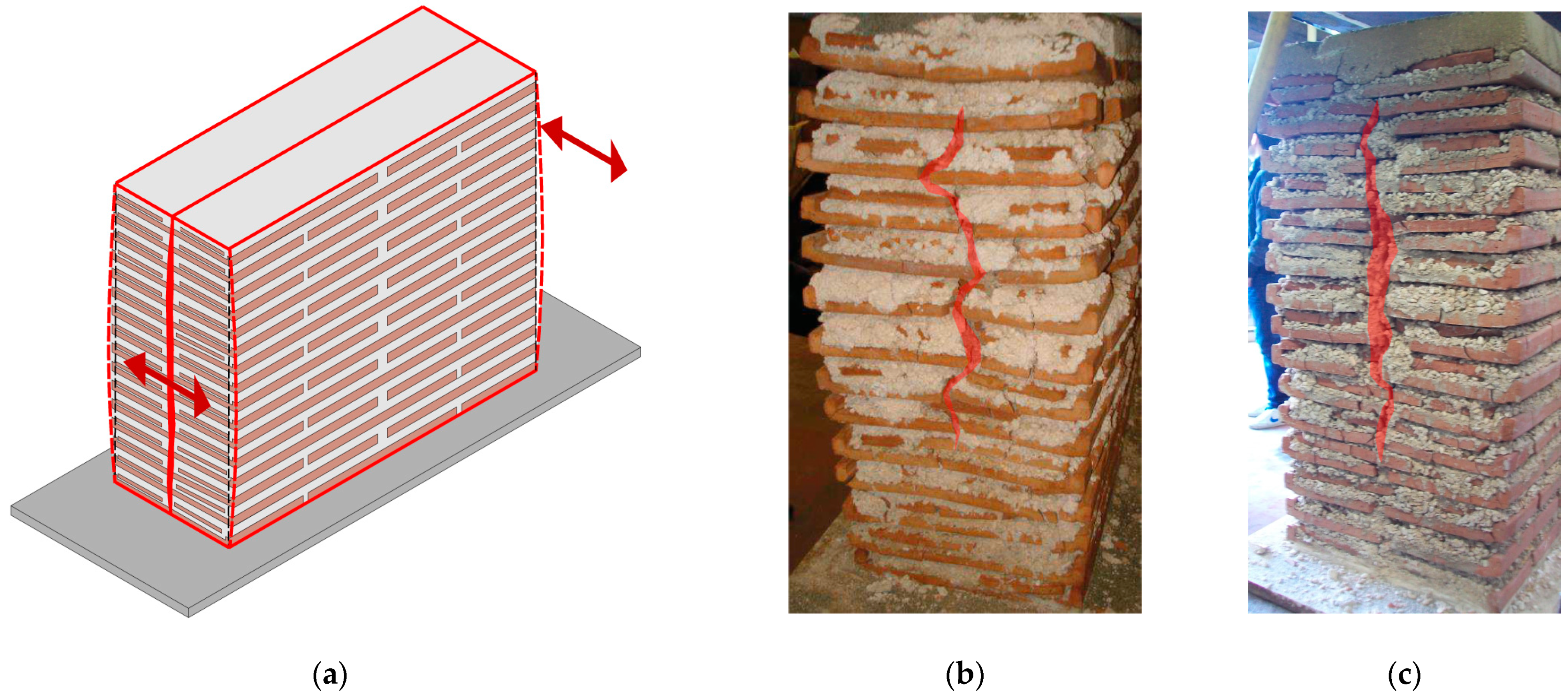
| Constituents | Volumes | Mortar Ratio |
|---|---|---|
| Gravel (2 ÷12 mm) | 8 | 1/4 |
| Coarse sand (0.5 ÷ 2 mm) | 6 | 1/3 |
| Fine sand (0.063 ÷ 0.5 mm) | 4 | 1/2 |
| Hydraulic lime | 2 | - |
| Water | 4 | 1/2 |
| Wall Specimen | σfc | σmax | εσmax | E | R2 | cn | cn−1 | |
|---|---|---|---|---|---|---|---|---|
| MPa | MPa | - | MPa | - | - | |||
| WMT_1 | 0.96 | 1.76 | 0.030 | EW−1 | 213 | 0.9933 | - | - |
| WMT_2 | 0.76 | 1.92 | 0.026 | EW−2 | 125 | 0.9989 | - | - |
| WMT_3 | 0.38 | 1.28 | 0.039 | EW−3.1 | 154 | 0.9670 | - | - |
| EW−3.2 | 200 | 0.9871 | 0.23 | 0.23 | ||||
| EW−3.3 | 252 | 0.9662 | 0.39 | 0.21 | ||||
| EW−3.4 | 276 | 0.9667 | 0.44 | 0.09 | ||||
| FMT_1 | 1.23 | 2.22 | 0.032 | EF−1 | 153 | 0.9944 | - | - |
| FMT_2 | 1.12 | 1.89 | 0.033 | EF−2 | 98 | 0.9964 | - | - |
| FMT_3 | 1.08 | 2.27 | 0.034 | EF−3.1 | 119 | 0.9970 | - | - |
| EF−3.2 | 294 | 0.9982 | 0.59 | 0.59 | ||||
| EF−3.3 | 268 | 0.9904 | 0.55 | −0.10 | ||||
| EF−3.4 | 316 | 0.9906 | 0.62 | 0.15 | ||||
| Construction Techniques | σmax (MPa) |
|---|---|
| Min-Max | |
| Irregular Stone masonry (pebbles, erratic and irregular stones) [32] | 1.00–2.00 |
| Irregular masonry of soft stone (tuff, calcarenite) [32] | 1.40–2.20 |
| Adobe earth walls [36] | 0.77–1.20 |
| Cob earth wall [34], | 1.05–1.17 |
| Rammed earth walls [35] | 1.69–2.35 |
| Floor height | H | 3.5 | m | Concrete brick roof slab | WR,G | 1.4 | kN/m2 | |
| Building length | L1 | 10.0 | m | Overload -roof slab | Qk | 2.0 | kN/m2 | |
| Building width | L2 | 8.0 | m | |||||
| Walls thickness | s | 0.8 | m | Wooden inter-floor slab | WIF,G | 1.6 | kN/m2 | |
| Specific weight of masonry | γ | 18.0 | kN/m3 | Overload -inter-floor slab | Qk | 2.0 | kN/m2 | |
| N | 4511.36 | kN | fk | 1280 | kN/m2 | |||
| A | 31.36 | m2 | γM | 4.2 | - | |||
| N/(0.65A) | 221.32 | kN/m2 | < | fk/γM | 304.76 | kN/m2 | ||
Disclaimer/Publisher’s Note: The statements, opinions and data contained in all publications are solely those of the individual author(s) and contributor(s) and not of MDPI and/or the editor(s). MDPI and/or the editor(s) disclaim responsibility for any injury to people or property resulting from any ideas, methods, instructions or products referred to in the content. |
© 2023 by the authors. Licensee MDPI, Basel, Switzerland. This article is an open access article distributed under the terms and conditions of the Creative Commons Attribution (CC BY) license (https://creativecommons.org/licenses/by/4.0/).
Share and Cite
Quagliarini, E.; Carosi, M.; Lenci, S. Novel Sustainable Masonry from Ancient Construction Techniques by Reusing Waste Modern Tiles. Sustainability 2023, 15, 5385. https://doi.org/10.3390/su15065385
Quagliarini E, Carosi M, Lenci S. Novel Sustainable Masonry from Ancient Construction Techniques by Reusing Waste Modern Tiles. Sustainability. 2023; 15(6):5385. https://doi.org/10.3390/su15065385
Chicago/Turabian StyleQuagliarini, Enrico, Marta Carosi, and Stefano Lenci. 2023. "Novel Sustainable Masonry from Ancient Construction Techniques by Reusing Waste Modern Tiles" Sustainability 15, no. 6: 5385. https://doi.org/10.3390/su15065385





